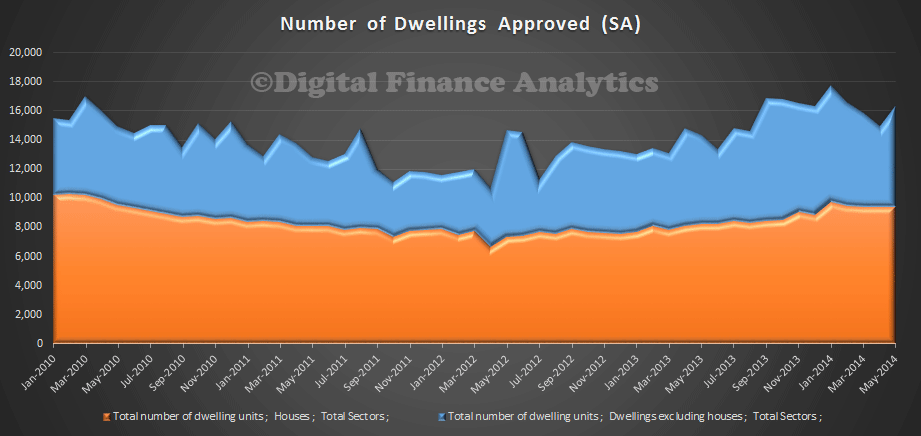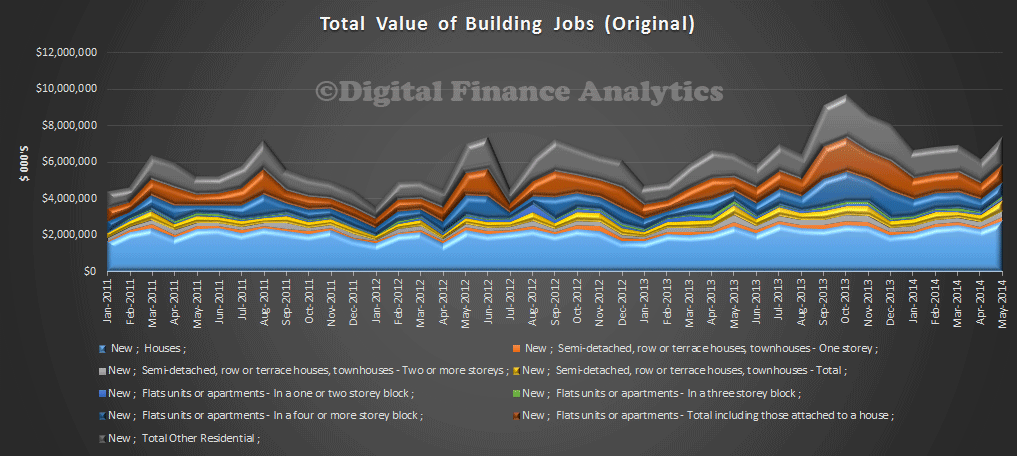According to the ABS, in data released today, the number of dwellings approved fell 1.7 per cent in May 2014, in trend terms, and has fallen for five months. However, the seasonally adjusted estimate for total dwellings approved rose 9.9% in May after falling for three months. Approvals for units increased. The seasonally adjusted estimate for private sector dwellings excluding houses rose 27.2% in May after falling for three months. The seasonally adjusted estimate for private sector houses rose 0.5% in May after falling for three months.
 Dwelling approvals increased in trend terms in the Northern Territory (8.2 per cent) and Tasmania (6.5 per cent). Dwelling approvals decreased in trend terms in the Australian Capital Territory (9.5 per cent), Queensland (3.2 per cent), New South Wales (3.0 per cent), South Australia (1.6 per cent), Western Australia (0.5 per cent) and Victoria (0.2 per cent). In trend terms, approvals for private sector houses fell 0.2 per cent in May. Private sector house approvals rose in Queensland (0.3 per cent), Victoria (0.2 per cent) and Western Australia (0.2 per cent). In trend terms, approvals for private sector houses fell in New South Wales (2.1 per cent) and South Australia (0.6 per cent).
Dwelling approvals increased in trend terms in the Northern Territory (8.2 per cent) and Tasmania (6.5 per cent). Dwelling approvals decreased in trend terms in the Australian Capital Territory (9.5 per cent), Queensland (3.2 per cent), New South Wales (3.0 per cent), South Australia (1.6 per cent), Western Australia (0.5 per cent) and Victoria (0.2 per cent). In trend terms, approvals for private sector houses fell 0.2 per cent in May. Private sector house approvals rose in Queensland (0.3 per cent), Victoria (0.2 per cent) and Western Australia (0.2 per cent). In trend terms, approvals for private sector houses fell in New South Wales (2.1 per cent) and South Australia (0.6 per cent).
The value of total building approved fell 3.3 per cent in May, in trend terms, and has fallen for six months. The value of residential building fell 1.1 per cent, while non-residential building fell 7.6 per cent in trend terms.
 However, the seasonally adjusted estimate of the value of total building approved rose 26.1% in May after falling for four months. The value of residential building rose 13.5% after falling for three months. The value of non-residential building rose 59.5% after falling for four months.
However, the seasonally adjusted estimate of the value of total building approved rose 26.1% in May after falling for four months. The value of residential building rose 13.5% after falling for three months. The value of non-residential building rose 59.5% after falling for four months.
So depending on your point of view, building approvals are either up or down in May! DFA’s view is that the seasonally adjusted data is probably a better read, indicating that the effects of low interest rates and the demand for property in a rising price market is stimulating approvals.
